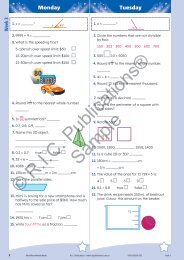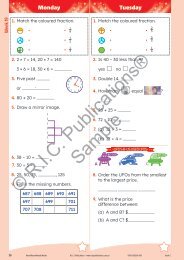PR-0552UK Primary Science - Book 2
Create successful ePaper yourself
Turn your PDF publications into a flip-book with our unique Google optimized e-Paper software.
Making sounds<br />
Sound ~ Activity 2<br />
Objectives<br />
• explore ways of making different<br />
sounds using a variety of<br />
materials<br />
• design and make a range of<br />
simple percussion instruments<br />
Working scientifically<br />
• Questioning<br />
• Observing<br />
• Predicting<br />
• Investigating and experimenting<br />
• Recording and communicating<br />
Designing and making<br />
• Exploring<br />
• Planning<br />
• Making<br />
• Evaluating<br />
Background information<br />
We hear sounds when vibrating air<br />
hits our ears.<br />
We hear sounds when the vibrations<br />
travel to our ears. The bigger the<br />
vibration, the louder the sound. The<br />
bigger the size, the more sound<br />
energy. The harder you hit, blow or<br />
strum an instrument or object, the<br />
louder the sound.<br />
Sounds can travel through many<br />
different materials. Ways to produce<br />
sounds include banging, scraping,<br />
tapping, strumming, purring,<br />
plucking, blowing, twanging and<br />
drumming.<br />
Before the lesson<br />
Materials needed<br />
• Drinking straw, jar with lid, counters, elastic bands, cereal box, glass bottle,<br />
steel ruler, tins, pebbles, cardboard tubes, biscuit tin, dried peas, greaseproof<br />
paper, bottle tops, plastic bottle, string, cardboard, paper, adhesive tape, blutack®<br />
etc.<br />
Preparation<br />
• Organise the pupils into groups of five or six. Distribute the materials evenly<br />
between each group.<br />
The lesson<br />
Stimulus<br />
• Play a variety of instruments. Ask the class to describe the sound (high,<br />
low, loud, soft etc.) Ask the class how the sound was made; for example, by<br />
banging, scraping, tapping, strumming, purring, plucking, blowing, twanging<br />
and drumming. Write these words on the board to help the class make their<br />
instruments.<br />
What to do<br />
• Pupils have a variety of materials available to them to create a musical<br />
instrument. Working in pairs or independently, the pupils choose materials to<br />
create an instrument.<br />
• Pupils make their instrument.<br />
• Ask for volunteers to show and play their instruments.<br />
• Pupil complete the worksheet.<br />
After the lesson<br />
Answers<br />
• Answers will vary<br />
Additional activities<br />
• Pupils plan another instrument. This time they create a design plan for their<br />
instrument, labelling the materials they need and explaining how they will<br />
construct it.<br />
• Pupils play with a number of instruments (drums, tambourine, recorder etc.)<br />
and describe how the sound is being made.<br />
Viewing Sample<br />
Display ideas<br />
• If available, take photographs of the pupils making and playing their instruments.<br />
Display the photographs in the classroom.<br />
52 <strong>PR</strong>IMARY SCIENCE ~ Prim-Ed Publishing ~ www.prim-ed.com


















